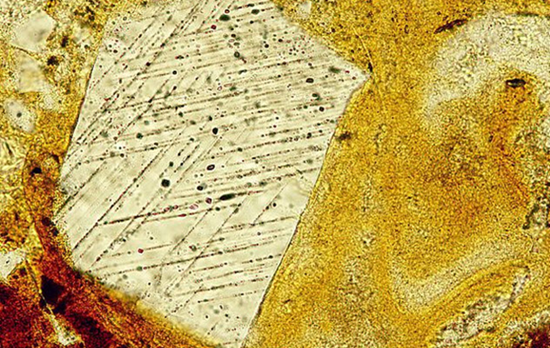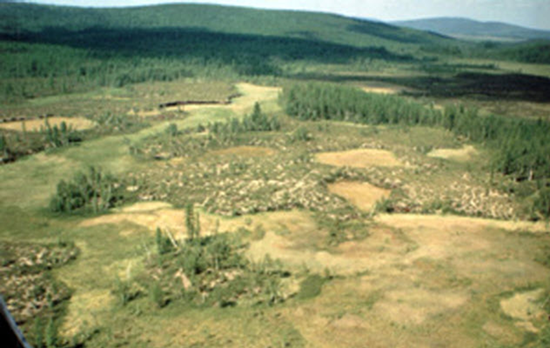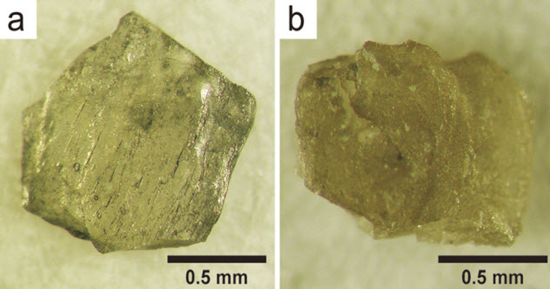
Meteorites are uncontrollable, unpredictable, and everywhere. Earth already bears the scars of countless impacts. Looking at them gives us strange insights into how our world was formed and possibly what’s in store for us in the future.
10. The Human-Sized Sea Scorpions
Photo credit: Apokryltaros
We all know that the prehistoric world had terrifying creatures. In 2015, another was discovered in the fossil remains of a meteorite crater in Decorah, Iowa. After the meteorite hit Earth around 470 million years ago, the area was flooded with ocean water. The resulting thick, brackish ocean water created the perfect environment for the human-sized sea scorpion that scientists have named Pentecopterus after a type of ancient Greek warship.
When a nearby river was dammed in 2010, the fossils appeared in the newly revealed crater. Scientists found a wealth of adult and juvenile specimens, some still showing the patterns on their skin. Looking like something out of a science fiction movie, adults reached sizes up to 2 metres (6 ft) long and sported massive limbs for grabbing and holding their prey.
Some of the fossils even showed tiny hairs that covered their hard exoskeletons. These hairs would have helped the creature to detect changes and movement in its environment as well as providing excellent manoeuvring ability in the dark water. Most of all, they could help the scorpion home in on anything nearby.
Their armored bodies included a massive head shield, and their adaptations likely made them the largest predators of their day. With their ability to live in the oxygen-poor water at the bottom of the crater, they had the upper hand when it came to battling for survival.
This discovery also pushed back the family tree of the eurypterids, proving that they were roaming the Earth as long as 467 million years ago, about nine million years earlier than previously thought. If all that isn’t creepy enough, they still have modern-day descendants: ticks and spiders.
9. Reidite The Super Diamond
The Rock Elm meteorite crater in western Wisconsin was created 465–475 million years ago. A meteorite traveling at around 110,000 kilometres per hour (70,000 mph) hit the Earth and created a hole that was about 6 kilometres (4 mi) across and 300 metres (1,000 ft) deep. It was only in 2014 that the crater yielded something unexpected, a rare mineral that’s also one of the hardest on Earth.
Reidite has only been found in three other meteorite craters. The Rock Elm sample is the oldest. A form of zircon, reidite was first identified in 1960 and found in craters in Virginia, Germany, and China.
According to the scientist who found it, the discovery was rarer than a 4.4-billion-year-old zircon. But that’s not surprising given that the traces of mineral are thinner than a human hair. They’re only identified conclusively under a microscope, which allows scientists to look at how the sample reflects light.
Reidite forms under pressure like zircon and diamonds do. While it only takes the pressure of the Earth to make a diamond, it requires the pressure of a meteorite impact to make reidite. The end product has the same composition as zircon, but it’s about 10 times more dense.
8. Twin Meteorite Impacts
It’s devastating enough when a single meteorite strikes the Earth, but two at the same time? Uncommon and unlikely, perhaps, but it happened in Sweden.
About 460 million years ago, two asteroids struck what is now Jamtland at the same time. Researchers from the University of Gothenburg traced the event to a major collision between two nearby asteroids that had been orbiting in the asteroid belt between Jupiter and Mars. The collision created countless smaller pieces, which then bombarded the Earth and the other nearby planets.
Samples from the impact craters have been aged to show that they happened at precisely the same time in a unique coincidence. The bizarre, double-crater formation is somewhat lopsided, with the diameters of the two craters measuring around 8 kilometres (5 mi) and 700 metres (2,300 ft), respectively.
At the time, the area of the impacts was completely underwater. The impacts of these meteorites would have parted the seas, leaving the seabed completely dry for more than 1.5 minutes before the waters rushed back with a giant wave that completely changed the face of the planet’s surface.
7. Quasicrystals
Photo credit: Paul J. Steinhardt et al.
Crystals are formed by a repeating pattern of atoms that lock together, with the molecular structure of naturally formed crystals being fairly similar. For example, when they have six-sided atoms, they bond together without any gaps.
In 2015, researchers found something entirely different in a 4.5-billion-year-old meteorite that had been recovered from a Russian crater. They call it a quasicrystal because, unlike terrestrial crystals, this odd material is made up of a series of 10-sided atoms that are stacked on top of each other to form a tube.
Their 10 sides mean that when they combine, they have to do so unevenly, making them a rather messy version of the ordered crystals that are formed on Earth. The atoms found in this quasicrystal don’t usually bind together in nature. Aluminium usually binds first to oxygen, which keeps it from binding to other things like iron and nickel as it did in this quasicrystal.
Only one other quasicrystal has ever been found, and that was in 2009 from another meteorite in Russia. That crystal had five sides, another structure that’s not usually found on our planet. The age of the meteorites means that the crystals are of extraterrestrial origin and were formed around the time that the universe was created.
The implications are staggering. These irregular crystals have broken some of the cardinal rules of crystal science. Researchers aren’t sure how such a crystal would have formed and whether it’s a common occurrence on worlds other than our own.
6. The Ancient Asteroid
Photo credit: Jacques Descloitres
When a meteorite hits the Earth, the force of the impact usually vaporizes it. Only bits and pieces are left. So the fossilized meteorite that was unearthed in the Morokweng crater of South Africa was a bit of a surprise.
The meteorite fragment was about 25 centimetres (10 in) in diameter and was found 750 metres (2,500 ft) below the surface of the Earth. Although it’s not the largest meteorite to hit our planet, it is the largest piece of a meteorite that’s been found as of late 2015.
Discovered in the 1990s, the crater is estimated to be around 145 million years old and is about 70 kilometres (45 mi) wide. It’s incredible that so much of the meteorite survived intact, especially when the formation of an impact crater only a fraction of the size of Morokweng can generate temperatures up to 14,000 degrees Celsius (25,000 °F). That temperature vaporizes the meteorite or fuses it into the surrounding rock, usually leaving only small fragments for study.
An analysis showed that this meteorite fragment contains a higher amount of uranium than most fragments. That makes it a bit more radioactive than most meteorites. It is also much older than any substantial piece studied to date.
5. Haughton Crater Impact Zone
Photo credit: Martin Schmieder
When researchers from the University of Western Ontario took a close look at rocks from the impact zone of Canada’s Haughton Crater, they found that the incredible pressure and temperatures generated during an impact changed the rocks to make them far more suitable for sustaining early life.
In addition to creating microscopic pores inside the rocks that are perfect for the tiniest organisms and bacteria, the trauma of an impact makes the rocks capable of blocking a greater than normal amount of ultraviolet rays. These so-called shocked rocks have their internal structure changed to reflect UV light while still letting in enough sunlight for photosynthetic bacteria to thrive.
So far, the conditions from meteorite impacts are one of the only environments that appear able to sustain life on a young planet with no atmosphere. A similar situation of pressure, heating, and cooling occurs in volcanic environments where lava takes a long time to cool. However, those who are looking for life on other planets are looking at impact craters first.
4. Lake Cheko
Photo credit: Tungus1908
On June 30, 1908, a massive explosion rocked the Podkamennaya Tunguska River area of Siberia. For hundreds of square kilometers, people reported seeing bright lights. When it was finally investigated, it was found that rows upon rows of trees had been flattened.
The exact cause of the explosion has been debated for decades, largely because no one has been able to find an impact crater for the presumed meteorite. Although some people believe that this points to the work of aliens, mainstream scientists think they have finally found the cause of the strange event.
In 1999, a team from the Marine Science Institute of Bologna in Italy was taking some measurements in nearby Lake Cheko, a few miles north of the location estimated as ground zero for the blast. But they found that it wasn’t the typically round, basin-shaped impact crater. Instead, it was exactly what would happen if the impact had a low-trajectory arc that plowed a furrow into the Earth rather than impacting it directly.
They hypothesize that a piece of rock approximately 10 metres (30 ft) long survived vaporization and hit the ground at a relatively slow speed for an extraterrestrial impact - about 1 kilometre per second. After it landed, it melted the permafrost in a process that opened up the lake, producing its odd shape and funnel-like bottom. Drilling samples from the lake supported their theory.
3. The Popigai Diamonds
Photo credit: Hiroaki Ohfuji et al.
Approximately 100 kilometres (60 mi) wide, the Popigai crater in the desolate Siberian plain was formed around 36 million years ago by an asteroid that was probably about 8 kilometres (5 mi) wide. According to the Novosibirsk Institute of Geology and Mineralogy, the meteorite also left behind trillions of carats of diamonds.
The Russians claim to have known about the diamond reserves since the 1970s but kept it secret to prevent the diamond market from destabilizing and reducing the value of their Mirny mine. Now that the mine is closed, they say they’re willing to exploit this other resource containing diamonds that are twice as hard as the standard variety.
According to geologists at Colgate University, there are a few ways that Russia could have ended up with this treasure trove of diamonds. The meteorite may have hit a diamond-rich vein in kimberlite pipes, which are volcanic deposits that are already well documented in Siberia. Theoretically, the impact could have created super diamonds, but such an occurrence would be a long shot.
It’s also possible that the meteorite was filled with carbon structures that were flash-fused into diamonds on impact. Finally, the carbon-rich area may have already been on Earth, and the impact created diamonds.
2. The Asteroid Destroyers
Photo credit: Parent Gery
Many smaller meteorites called L-chondrites fell to Earth without leaving massive impact craters. Until recently, scientists were puzzled by the origin of these space rocks, many of which landed about 460–470 million years ago.
The Thorsberg quarry in Sweden, a source of pink limestone, has also yielded many fossil meteorites over the years. In 2011, workers unearthed a 470-million-year-old rock that was unlike anything previously found. Scientists nicknamed it “mysterious object,” but that doesn’t do it justice. Structurally, it’s similar to a group called primitive achondrities. But it’s not an L-chrondrite.
So far, all the meteorites found in the quarry have been from the same cataclysmic event: the collision of two extraterrestrial bodies. Until recently, we’d only found remains of one of those bodies that hit the Earth about 470 million years ago. But it’s likely that “mysterious object” was part of the rock that formed the other half of the collision: the asteroid killer.
It took about one million years for pieces of the destroyed asteroid to reach Earth. This piece has helped scientists to isolate and identify spinels, the signature minerals left behind by different kinds of meteorites. The distinctive signatures of these minerals will allow researchers to determine how many meteorites have hit Earth in the past 2.5 billion years.
1. The Impact Crater With No Extinction Event
The Chicxulub impact crater in Mexico made headlines when it was confirmed to have been the major cause of the dinosaurs’ extinction about 65 million years ago. Extinction events happen with meteorites of that size, with the possible exception of a meteorite that hit Australia around 300 million years ago.
The crater in Australia is now buried underground. More accurately, it’s two massive domes that may have occurred when a huge asteroid of unprecedented size split in two on impact to form the two craters.
When you compare it to the dinosaur doomsday crater, it gets even more terrifying. Chicxulub is around 180 kilometres (110 mi) wide. Scientists estimate that the asteroid that caused this crater was about 10 kilometres (6 mi) wide. By comparison, the impact zone of the Warburton Basin asteroid in Australia is twice that size, and it’s now buried 30 kilometres (20 mi) underground.
When a geothermal research team discovered the Australian crater, they didn’t find an extinction event to go along with the impact, which is the largest ever found on Earth. Magnetic imaging clearly shows the resulting devastation and buckling of the rock from the impact. This should have created a massive shift in the life on Earth at that time.
In addition, scientists can’t find an ash layer or other marker in the rock strata that indicates the fallout of the enormous explosion that must have occurred. So while we’ve found the largest scar on the surface of the planet so far, we have simply no idea what happened after the impact.







No comments:
Post a Comment
Please adhere to proper blog etiquette when posting your comments. This blog owner will exercise his absolution discretion in allowing or rejecting any comments that are deemed seditious, defamatory, libelous, racist, vulgar, insulting, and other remarks that exhibit similar characteristics. If you insist on using anonymous comments, please write your name or other IDs at the end of your message.